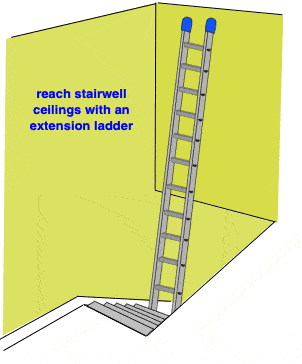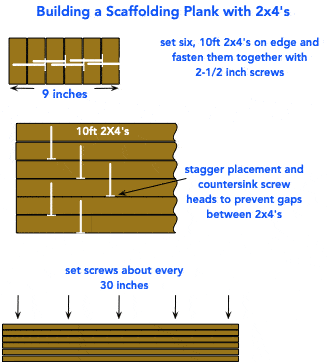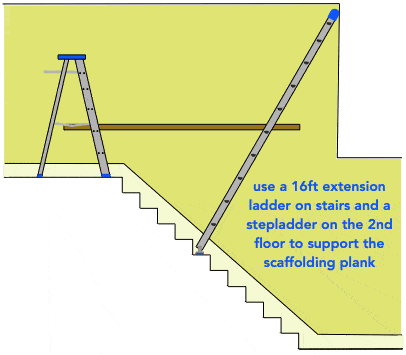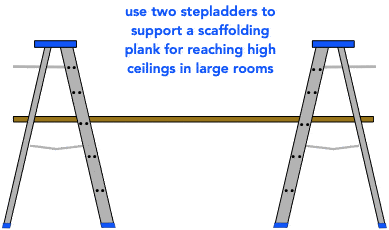Tips for Painting High Ceilings and Stairwells
by: Dale Cox
To make using these improvised scaffoldings safer, keep the lengths of dimension lumber as short as possible and be sure they are well supported by the ladders or other props used. Walk slowly and with care when standing on the scaffolding and where possible, clamp the boards to the supports.
To avoid tripping or slipping when walking over floors, cover them with canvas drop cloths, not plastic. Tuck the cloths into the corners at each step riser and other edges to form a clear, smooth surface for walking. Also, tie or tape a drop cloth around any banisters or other rails to keep it in place while you work.
If you need to paint high walls and ceilings in a stairwell or a great room, you'll need to use an extension ladder and maybe build scaffolding to reach some of the farthest points. On this page are a few tips and techniques for working in stairwells and building quick, improvised scaffolding with dimension lumber.
If you don't want to deal with ladders at all, another method for painting a high ceiling while standing on the floor is also described here. This requires attaching a brush to an extension pole and using the same color paint on both the ceiling and walls.
Using an Extension Ladder

To reach stairwell ceilings for painting projects and other work, use an extension ladder as shown here. Set it on a stair tread and lean it against the stairwell wall. A 16 foot ladder will reach a two story ceiling but higher work may require 20 or 24 feet.
To protect the wall, pad the ends of the ladder using colorfast rags that won't transfer dye to surface. Wrap several turns of rag around the ends and hold it in place with masking tape. To hold a paint pail while working from the ladder, use a bucket hook and hang it from one of the rungs and off to the side.
Improvised Scaffolding

In larger stairwells it may be impossible to reach the midpoint of some walls using an extension ladder alone. In these cases, use two ladders and a scaffolding plank to provide support.
You can buy a scaffolding plank like the one at this link or you can build one using 10 or 12ft 2x4's as illustrated here.
Using six 2x4's set on edge and fastening them together with 2-1/2 inch screws, you can build a nine-inch-wide scaffolding plank that can be supported with ladders.
Scaffolding to Reach Stairwell Ceiling

To use a scaffolding plank in a stairwell, an extension ladder is set on one of the stair treads and a stepladder is set on the second floor at the top of the stairs.
Be sure to place the ladders close enough together that the plank is well supported on both ends. Overlap the plank by a foot or more on the ladder rungs at both ends and if desired, use clamps to secure it in place for more stability.
Walk slowly and with care while on the plank to minimize vibration that could cause the stepladder to move and become unstable.
Stepladder Scaffolding

To paint and repair vaulted and cathedral ceilings, use two stepladders and a scaffolding plank to build a moveable support. Keep the ladders fairly close together and use the shortest plank possible. Walk slowly on the plank to avoid vibration that could cause the ladders to shift and the board to become unstable. Clamp the plank to the ladders to improve stability.
In an average sized room for faux finishes or other projects requiring swift movement across a wall, a small scaffolding can be built using two 4ft stepladders and a 10 or 12ft plank. For high ceilings in larger rooms, eight or 10 foot stepladders can be used to reach heights of up to 16 feet or so.
Painting High Ceilings from the Floor
Using one color for both the walls and ceilings will make it possible to paint the corners with a brush and then roll the remainder, all while standing on the floor. Also, using flat latex paint will improve the results because it will not show brush and roller marks which are hard to avoid when working with a long pole. If you're choosing the colors for the job, using one that closely matches the existing color will make coverage easier. If you must have a white ceiling with an accent color on the walls, a ladder will be required to do the job so use one of the scaffolding methods above.

To work from the floor, use a roller extension pole long enough to reach to the ceiling. Twelve feet is usually the limit for these but this is long enough for most situations.
To do the painting, fill a brush with paint and tape it to the end of the extension pole using masking tape. Set the brush so the end of the pole presses against the ferrule and then wrap a few turns of tape around the two, near that point. Wrap a few more turns of tape a couple inches farther down the brush handle to hold it to the pole in two places.
Extend the pole and start at the farthest corner, brushing the paint on as far as it will go. When the brush runs dry, compress the pole to pull it in and load more paint. Carefully dip the brush into the can while still attached to the pole and tap on the sides of the can to stop drips. Extend the pole again and coat more of the corner. Paint all the high corners along the ceiling and down the walls to a point where you can reach from the floor or a small ladder. Let the corners dry and apply a second coat if necessary. To finish, roll the ceiling first and then the walls using the extension pole and a roller. Use a shorter pole as you work your way down to finish the walls.